
How psychology works the facts visually explained (DK) (Z-Library)
.pdf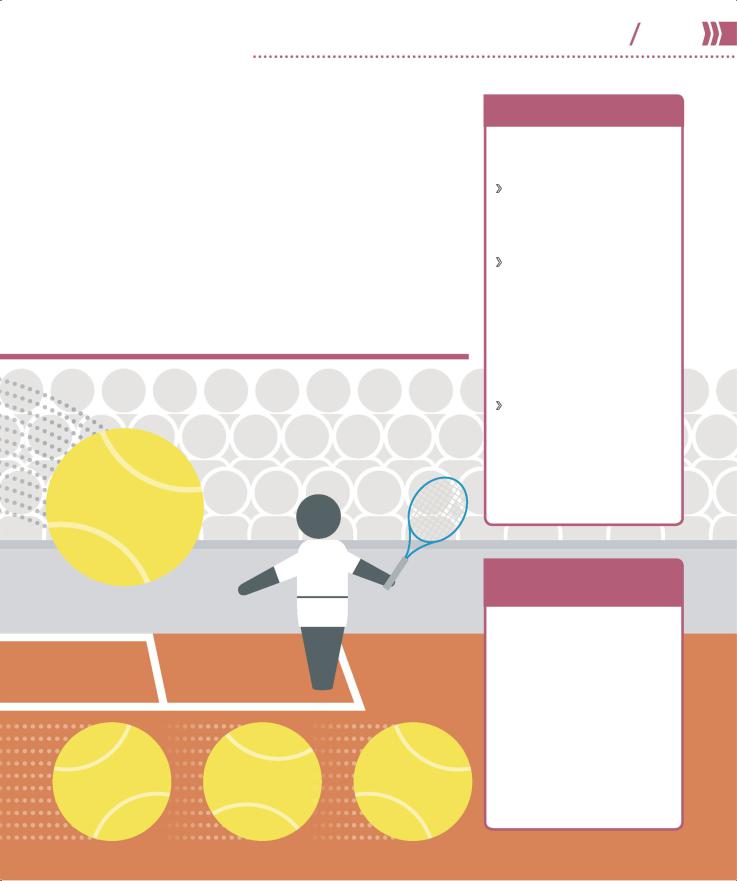
PSYCHOLOGY IN THE REAL WORLD |
238 239 |
The psychology of sports |
“The sky has no limits. Neither do I.”
Usain Bolt, Olympic sprint champion
physical movements become more familiar, rehearsed, and automatic. Finally, there is a plateau in the learning curve, when the learner stops progressing because they are bored or because the next stage seems too complex. To move on and up from the plateau, the learner or their coach needs to reset the goal, ensure physical readiness for the next step,
shorten practice times to avoid fatigue, or break down the skill into parts.
Some skills are totally within the learner’s control (closed) and others require the player to react (open), for instance, by returning a ball (below). Different types of practice are suited to each type of skill, but the more enjoyable the training is, the faster the learner moves on.
OPEN SKILLS
Receiving the ball in tennis is an open skill, so the player must cope with a changing and unpredictable environment. Weather, terrain, and opponents are all variables to which an athlete might need to adapt.
PHASES OF LEARNING
Athletes pass through three stages of learning when they are trying to master a new skill.
Cognitive or understanding phase Performing the skill requires all of the athlete’s attention. It is a process of trial and error, with a low success rate.
Associative or verbal motor phase Performance is more consistent in this stage as motor programs (ways in which the brain controls movements) form. Simpler elements of the skill now look fluent, but more complex elements require attention. The athlete is also more aware of what is going wrong.
Autonomous or motor phase
Performance is now consistent and fluid, motor programs are stored in the long-term memory, and the skill is automatic, requiring little or no conscious effort. Spare attention can be focused on opponents and tactics.
4. Bring the racket |
5. Hit the ball at its |
6. Follow through by |
|
head up behind |
|||
highest point with |
bringing your racket |
||
you and then drop |
|||
the center of the |
down near your |
||
it behind your head, |
|||
racket head. |
opposite foot. |
||
bending your elbow. |
|||
|
|
FIXED OR VARIABLE PRACTICE
Sometimes known as drills, fixed practice involves repeatedly practicing a whole skill in order to strengthen muscle memory, making the skill more natural and automatic. This type of practice works best with closed skills.
Best used for open skills, variable practice involves performing a skill in varying situations. This helps
an athlete to build up a set of responses for multiple scenarios to use in competitive play.
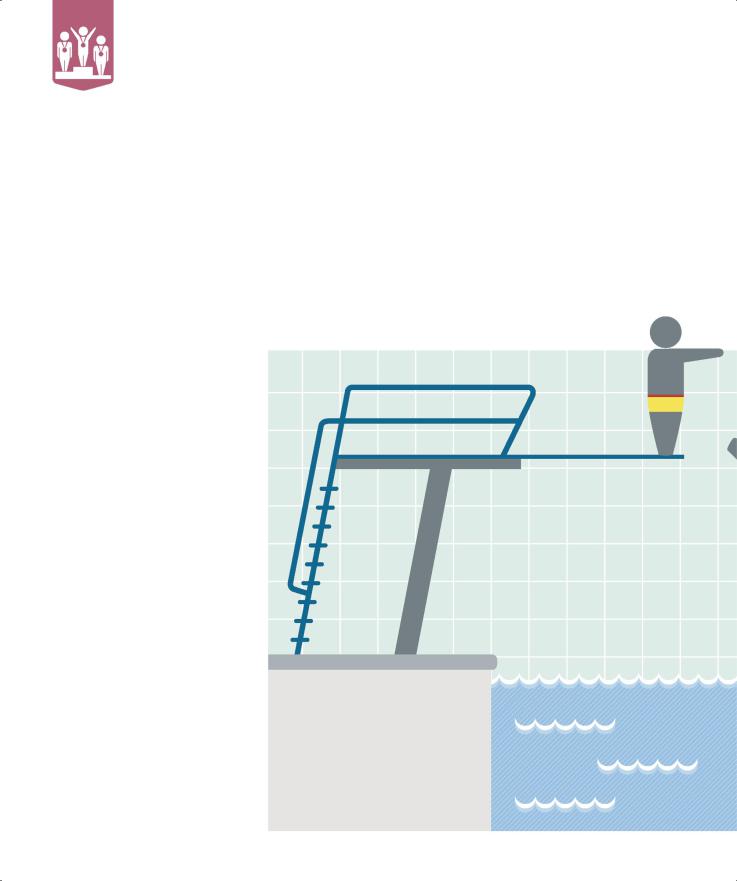
Keeping motivated
Athletes have to keep motivated. Without the continuous desire and drive to improve their performance, physical preparation and psychological factors such as focus and confidence fall apart.
How it works
Athletic training, conditioning, and competition require self-discipline and can be stressful. To set themselves realistic goals, athletes must maintain high levels of motivation, particularly when confronted with fatigue or failure. This motivation can be intrinsic (internal and personal) or extrinsic (based on external rewards).
When people participate in sports or exercise for the love of the activity or a sense of personal fulfillment, they are intrinsically motivated. Since this motivation reflects deeply held attitudes, it tends to be consistent and leads to better focus and enhanced performance. Making mistakes is less stressful for athletes who are intrinsically motivated because they focus on improving their skills rather than simply winning.
People who participate in sports or exercise in order to gain tangible
rewards or praise or to avoid negative consequences are extrinsically motivated. They focus on the outcomes of competitions rather than the rewards of training and preparation. Although extrinsic motivation is less consistent than intrinsic, it can be a powerful driver of competitive performance.
SMART goals
However a player is motivated, their goals are achievable only if they are SMART—specific,
measurable, achievable, realistic, and time-bound. One such goal might be to run 3 miles (5 km) in 30 minutes after six weeks of timed practice runs.
Intrinsic motivation
Intrinsically motivated athletes take part in sports for personal reasons, such as enjoyment, the challenge of competition, the desire to perform well and succeed, and skill improvement. In this case, the sheer thrill of diving is the motivation.
“… you need to find something to hold on to, something to motivate you … to inspire you.”
Staying motivated
Motivation is crucial to make athletes practice regularly, develop their skills, and perform to the best of their ability. Both internal and external factors drive motivation and setting regular goals maintains it.
REPUTATION
POINTS
PRIZES
Tony Dorsett, former running back
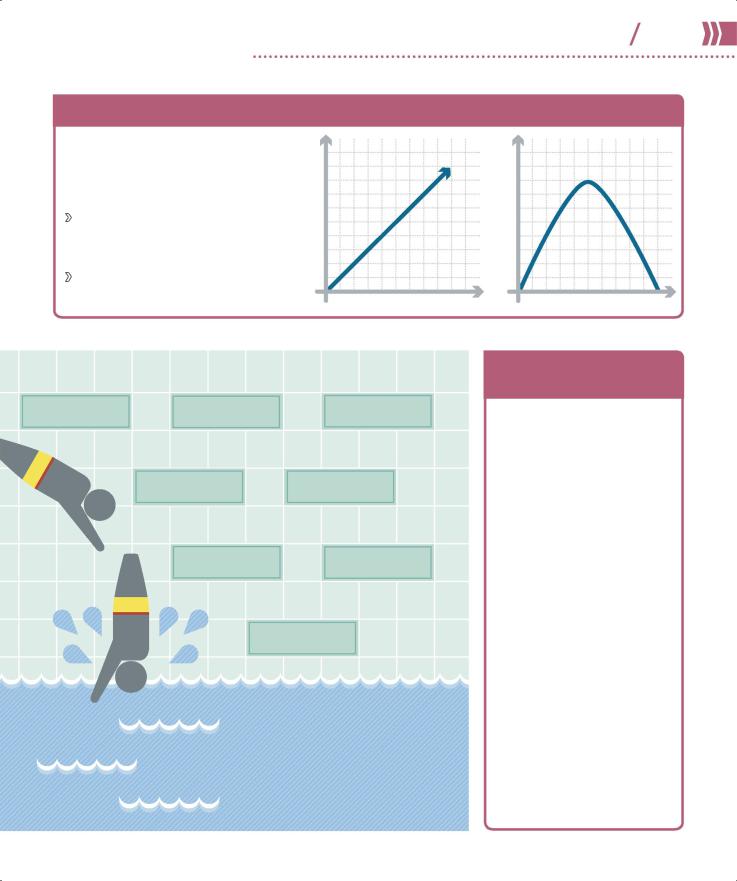
PSYCHOLOGY IN THE REAL WORLD |
240 241 |
The psychology of sports |
AROUSAL THEORY OF MOTIVATION
Arousal means the intensity of motivation, from boredom to anxiety or excitement. Outgoing people need high arousal to feel excited about sports, while shyer athletes perform better at lower arousal levels.
Hull’s Drive Theory Performance improves with arousal levels. Top athletes perform better under pressure due to their superior skills and ability to manage stress.
Inverted U Law Arousal improves performance, but only up to a point.
high
PERFORMANCE
low
HULL’S
DRIVE
THEORY
low AROUSAL high
PERFORMANCE
optimal arousal level
INVERTED
U LAW
AROUSAL
PRIDE |
MASTERY |
ACHIEVEMENT |
|
PURPOSE |
INTEREST |
AUTONOMY |
CURIOSITY |
BELONGING
PRAISE
AVOIDING PUNISHMENT
MONEY
Extrinsic motivation
Executing a perfect dive brings external rewards, such as medals, money, or recognition, and avoids unpleasant consequences such as being told off, penalized, or getting a low score. Extrinsically motivated athletes focus on the outcomes of competitions.
TEAM MOTIVATION AND SOCIAL LOAFING
Team performance does not necessarily improve as team size increases because of a concept called social loafing. Participants tend to contribute less to the group’s goal when there are many people involved than they would if they were doing the same task on their own. This can create conflict and have a negative impact on the team dynamic.
For example, if motivated team members repeatedly feel others are relying on them to do most of the work, they may deliberately reduce their workload or even stop collaborating so less productive members do not exploit them.
To overcome this problem, a coach may use performance
evaluation to define each player’s role, strengths, and weaknesses, and how they can individually benefit the team. This helps to ensure that everyone on the team is working toward a common goal.
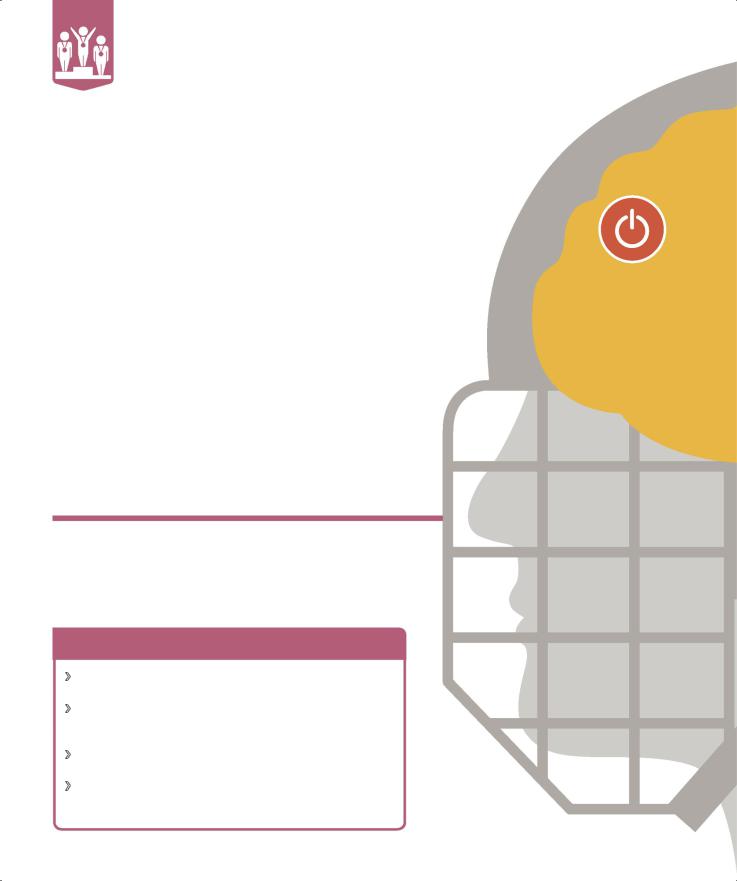
Getting in the zone
An optimal psychological state occurs when there is a balance between the level of challenge posed by an activity and a person’s ability to meet that challenge. It is called flow.
What is flow?
Hungarian psychologist Mihaly Csikszentmihalyi identified a state “in which people are so involved in an activity that nothing else seems to matter; the experience is so enjoyable that people will continue to do it even at great cost, for the sheer sake of doing it.” He defined this elusive state as “flow.”
Flow is one of the richest and most performance-enhancing experiences for an athlete. Sometimes described as being “in the zone,” this state of mind occurs when athletes feel fully engaged in their performance, lose their perception of time, are able to concentrate on the moment without any distraction, feel challenged but
not overwhelmed, and have a sense of being connected to something that is greater than themselves.
In a state of flow, performance becomes consistent, automatic, and exceptional.
Achieving flow
Whatever their level, athletes can find flow. Coaches can create an environment that is conducive to flow by encouraging commitment and achievement, setting teams and individuals clear goals, presenting athletes with activities that challenge
them but are within their capacity to perform, and offering consistent and nonjudgmental feedback.
Prefrontal cortex switches off
Higher thought processes such as problem-solving and self-criticism are temporarily deactivated.
Brain in flow
The brain experiences various changes in the flow state, enabling a person to be completely absorbed in the task and perform exceptionally well without conscious thought.
ACHIEVING FLOW
Choose an activity you love If you look forward to a task, you will find it easier to lose yourself in it.
Make sure it is challenging, but not too hard The task should be challenging enough to require your full concentration, but it should not be beyond your capabilities.
Find your peak time You can enter flow more easily during a time of peak energy.
Eliminate distractions Clearing away distractions allows you to focus completely on the task.
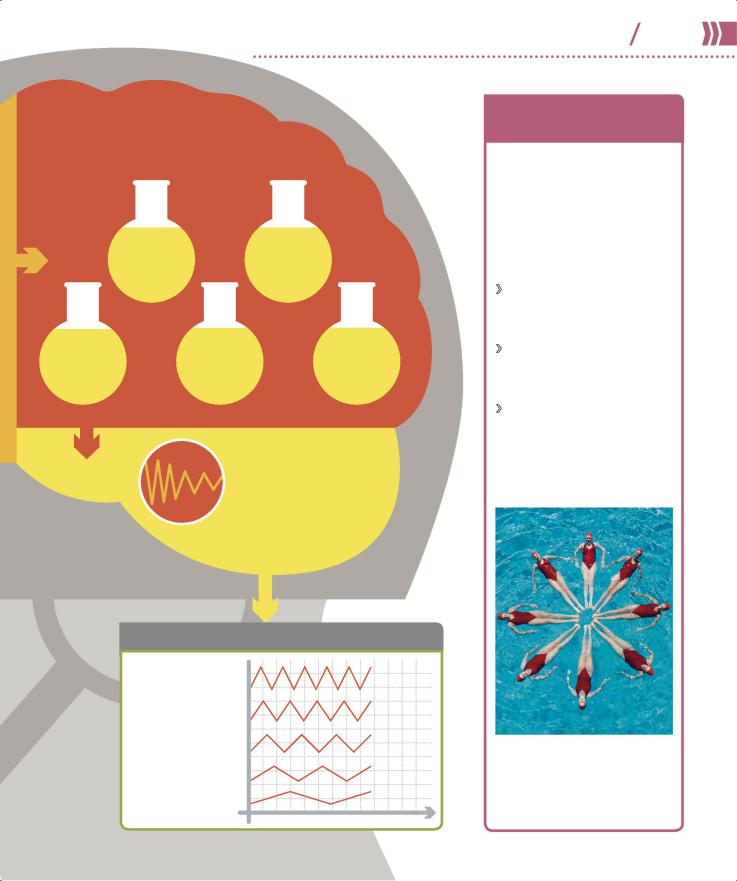
PSYCHOLOGY IN THE REAL WORLD |
242 243 |
The psychology of sports |
Neurochemicals are released
The brain releases a series of performance-enhancing neurochemicals.
|
E |
|
|
D |
|
|
|
|
N |
|
|
|
|
||
|
|
O |
|
|
|||
|
|
D |
|
P |
|
|
|
|
Relieves pain |
O |
Helps the player |
A |
|
|
|
|
P |
I |
|
|
|||
|
|
R |
|
|
M |
|
|
|
and makes |
|
to see rewards |
|
|
||
|
I |
N |
|
|
|||
|
|
H |
|
|
E |
|
|
|
the person |
N |
and act to |
|
|
|
|
|
|
|
|
|
|||
|
feel good. |
|
find them. |
|
|
|
|
S |
|
A |
|
|
N |
|
|
E |
N |
|
O |
|
|
||
|
R |
|
|
|
|||
|
|
A |
|
R |
|
||
|
O |
|
|
|
|||
|
|
N |
|
E |
|||
|
T |
|
|
P |
|||
Responsible |
Associated |
A |
|
||||
|
Makes the player |
N |
|||||
|
O |
|
D |
|
|
I |
|
for balancing |
N |
with feelings |
M |
|
concentrate |
|
P |
|
I |
|
|
|
|
|
E |
mood. |
N |
of bliss. |
I |
|
and feel |
|
H |
|
D |
|
|
||||
|
|
|
E |
|
|
|
R |
|
|
|
|
more alert. |
N |
I |
|
|
|
|
|
|
E |
|
|
|
|
|
|
|
|
|
|
TEAMWORK
AND FLOW
Sometimes, strong group members can help to bring about a flow state for the whole team. Flow is also critical in sports partnerships, such as doubles tennis, where the two must work as a unit, and even more so in figure skating, for example, where a mistake by one partner could make the other fall.
Unity and emotional connection between teammates provides the positive feedback that helps lift them to high performance levels.
Harmony between team members means they communicate more successfully than normal.
Calming down
Brain waves slow from the beta wave of normal waking consciousness to the dream-inducing borderline between alpha and theta waves.
Brain waves
Synchronized |
GAMMA |
|
electrical pulses |
31–100 Hz |
|
from neurons |
BETA |
|
communicating with |
||
16–30 Hz |
||
each other produce |
ALPHA |
|
brain waves. They |
||
8–15 Hz |
||
are divided into |
||
THETA |
||
speed bands (Hz). |
||
4–7 Hz |
||
The faster the speed, |
||
|
||
the more alert the |
DELTA |
|
person is. |
0.1–3 Hz |
The successful interaction between all members of a team is essential in sports such as rowing, in which if one teammate is out of rhythm or failing to keep up, the whole team suffers. Regular group practice is key.
JOINT EFFORT in sports such as synchronized swimming, where the parts form a greater visual whole, is vital as team members rely utterly on each other to reach the zone where perfection seems effortless.
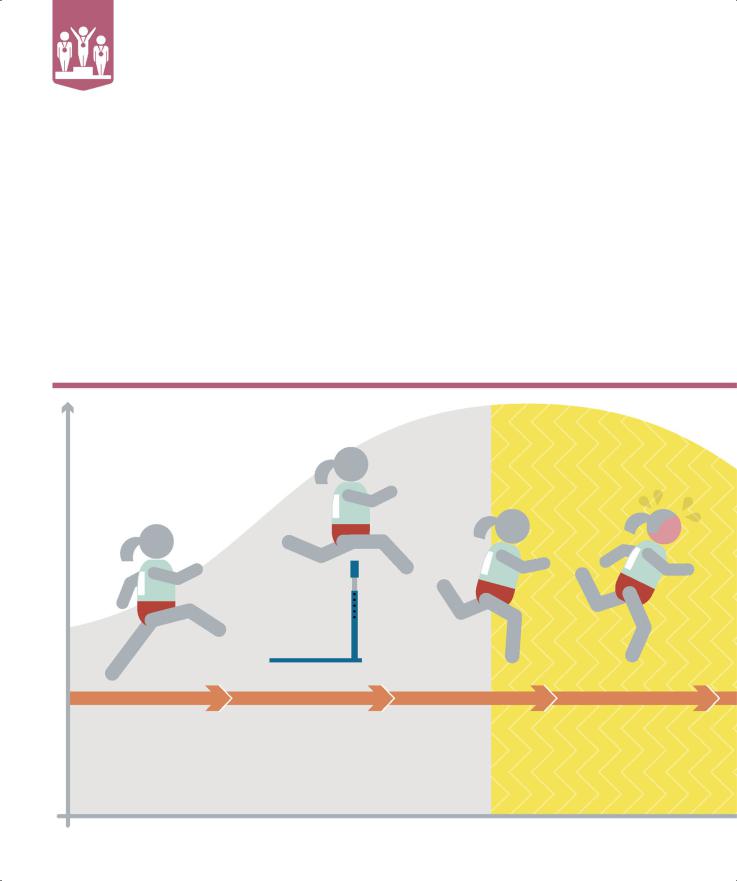
Performance anxiety
Nerves afflict many athletes, causing them to tense up and perform below their optimal level. There are psychological techniques to help manage such anxiety.
What is it?
A certain level of anxiety is normal and healthy before a match or contest, and actually improves performance. However, intense anxiety that continues during the contest itself can cause the athlete to underperform or even “freeze,” damaging self-esteem and ultimately hindering a career. Sometimes called “choking” or “stage fright”—performance
anxiety can affect actors and musicians, too—physical symptoms include a racing heartbeat, dry mouth, tight throat, trembling, and nausea. This is the fight-or-flight response—a flooding of adrenaline that puts the body in a state of high arousal. Psychological symptoms include a sudden, uncharacteristic reluctance to compete or loss of interest in the sport, fatigue, sleep disturbance, and even depression.
Performance anxiety can be triggered by self-consciousness and overthinking the physical moves. Many actions are best performed outside conscious awareness— instead relying on muscle memory— such as running, swinging a bat, or playing the violin. To achieve optimal performance, parts of the brain should be on automatic pilot rather than consciously monitoring the action.
The cycle of performance anxiety
Anxiety can cause a vicious cycle, in which the fear of making mistakes causes an athlete to freeze up. This only leads to the athlete making further errors, which then
feeds their terror of mistakes.
Stress zone
Once caught in the cycle of tension, self-consciousness, and negative self-talk, stress levels lead to making mistakes.
PERFORMANCE (PHYSICAL AND MENTAL)
HIGH-STRESS |
RUSH OF |
PHYSICAL TENSION |
INCREASED SELF- |
PERFORMANCE |
ADRENALINE |
IMPEDES SKILLS |
CONSCIOUSNESS |
Intense stress can |
Faced with a challenge, |
Tension locks up the |
The athlete feels |
motivate the athlete to |
the body produces a |
muscles, impeding skills |
physically awkward and |
perform to the best of |
rush of adrenaline, |
and stopping the athlete |
starts to focus on skills |
their ability, but it can |
sending the athlete into |
from performing tasks |
and actions that are |
also lead to anxiety. |
fight-or-flight mode. |
as well as normal. |
usually automatic. |
AROUSAL LEVEL |
|
|
|
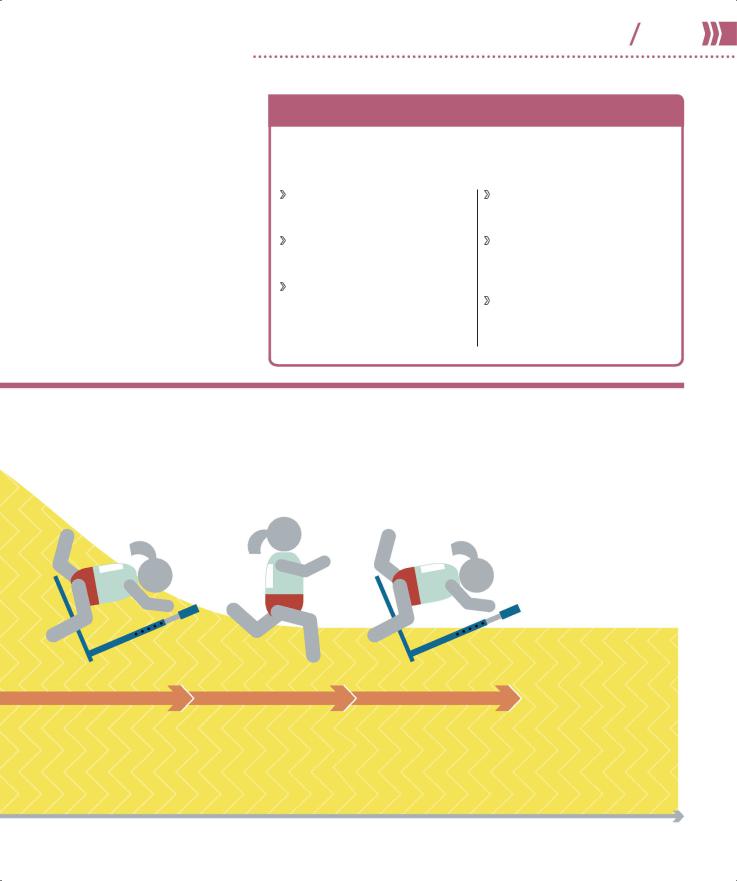
Who can help?
Working with a coach or sports psychologist can help a player to control the tendency to “choke” when performing. One important factor in overcoming the anxiety is the person’s level of confidence in their skills and abilities. By highlighting successes and celebrating efforts—and by avoiding adding too much performance pressure—a coach or sports psychologist can help build self-confidence and self-belief.
Over time this approach can help to prevent, minimize, and counteract performance anxiety.
PSYCHOLOGY IN THE REAL WORLD |
244 245 |
The psychology of sports |
MANAGING PERFORMANCE ANXIETY
While coaches and psychologists can help manage performance anxiety, there are also many techniques and practices that athletes can do on their own to reduce anxiety.
Normalize the nervousness
Everyone feels some performance anxiety—it is normal.
Prepare and rehearse Hone muscle memory and so build up confidence.
Visualize a successful performance Mentally walk through every step and imagine an experience free of pain
and anxiety.
Positive self-talk Challenge negative thoughts, and replace them with positive ones.
Take care of yourself Exercise, eat healthily, and allow time
for plenty of sleep before performance day.
Remember you are there to have fun Shift the focus from your performance to your pure enjoyment of the sport.
“Never let the fear of striking out get in your way.”
George Herman “Babe” Ruth, American baseball legend
FREEZING AND |
NEGATIVE INNER |
MORE ERRORS |
INCREASED ERRORS |
MONOLOGUE |
The negative inner |
As anxiety and tension |
Self-talk becomes more |
monologue increases |
mount, the athlete |
negative and critical, |
both anxiety and |
freezes up and cannot |
focusing on mistakes |
distraction from the task |
carry out their activity, |
and perceived |
at hand, causing even |
leading to more errors. |
weaknesses. |
more errors. |
Arousal levels
Up to a point, increased arousal can fuel good performance. However, if anxiety rises above that zone of optimal arousal, it causes self-doubt, freezing up, and errors.

Psychometric tests
First developed for use in educational psychology at the start of the 20th century, psychometric tests are popular today with employers who use them to analyze the suitability of new recruits.
What are they?
French psychologist Alfred Binet devised the first modern intelligence test in 1905 in response to a law that made it compulsory for children in France to attend school from the age of 6 to 14. Some children with learning difficulties were struggling to cope with the demands of the curriculum. The education system needed a way of measuring the extent of these difficulties so they could determine which children needed to receive special schooling. Binet set out to formulate tests that assessed innate ability and not scholastic achievement. He tested his methods
on his two daughters, as he was intrigued by the different ways in which they explored and responded to the world.
Helped by his colleague Théodore Simon, Binet developed 30 tests, some for each age group, to be given under controlled conditions. They ranged in
difficulty from, for example, counting the number of petals on a picture of a flower to drawing an image from memory. The aim was for the child to pass as many tests within their age group as possible, and reach a standard level of competence for their age. Psychologist Lewis Terman at Stanford University
adapted the tests, publishing the Stanford-Binet Intelligence Scales in 1916. These measures formed the basis of IQ tests for much of the 20th century. Psychometric tests today still owe much to the French–American work, although their scope has broadened, and they are more widely used to aid adult recruitment and career choice than to test children’s intelligence. Employers use psychometric tests to screen out unsuitable candidates and to match individuals to the most appropriate occupations. Therefore it is important that they have confidence in the accuracy of the tests.
MAKING THE TESTS FAIR
As psychometric test results can directly affect whether someone gets the job they want, they have to conform to rigorous standards. Tests should be:
Objective There must be no scope for the marker’s subjective views to affect the score.
Standardized Test conditions must be the same for all participants. There is a strict time limit for aptitude tests, usually a minute per question. However, personality questionnaires may not have a time limit, as accuracy and honesty are more important than speed.
Reliable There should not be any factors that could skew the results of the tests.
Predictive The tests must make an accurate prediction of how the participant will perform in real life.
Nondiscriminatory The tests must not put any participant at a disadvantage on the basis of, for example, their gender or ethnicity.
Types of test
Most employers who use psychometric tests include a personality questionnaire to assess a candidate’s
motivation, enthusiasm, and fitness for a particular working environment. As more jobs are now customer focused and there are generally fewer tiers of management, “soft skills” of communication and getting along with people, which personality tests can reveal, are increasingly important. The employer may also use aptitude tests to measure specific intellectual abilities against a standard score.
80%
of the top companies in the UK and US use psychometric testing when recruiting staff
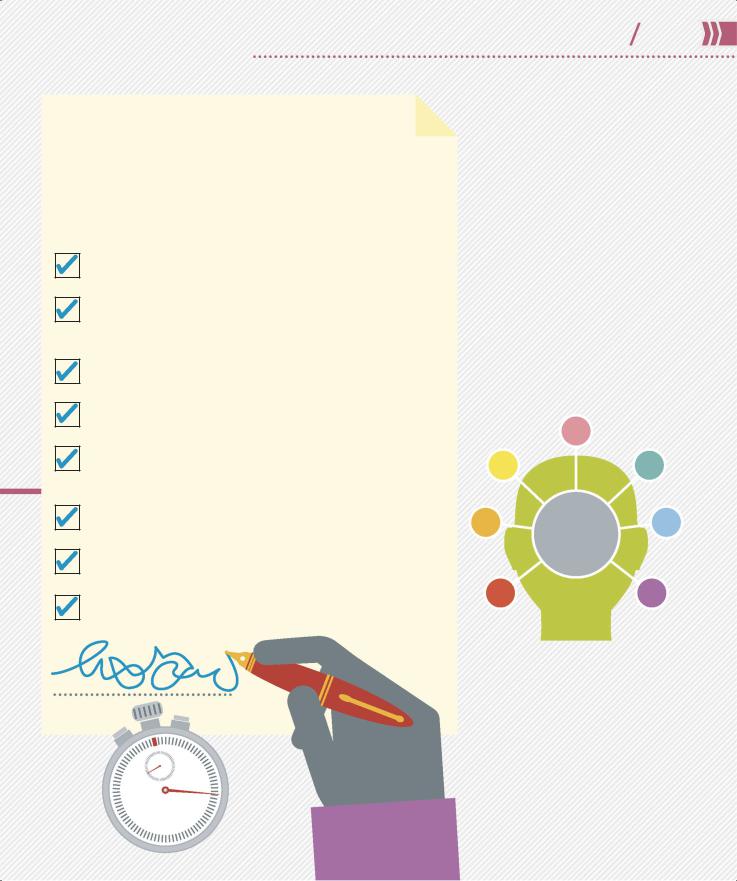
PSYCHOLOGY IN THE REAL WORLD |
246 247 |
Psychometric tests |
Aptitude tests
The participant answers multiple-choice questions (often online) under exam conditions on a range of subjects or on an area specific to the job they have applied for. Verbal, numeric, and abstract reasoning questions appear in most general aptitude tests to assess communication skills, numeracy, and ability to learn new skills, whereas other tests are more specialized.
Verbal ability Spelling; grammar; working by analogy; ability to follow instructions and evaluate arguments—for most jobs.
Numeric ability Arithmetic; number sequences; basic mathematics—for most jobs. Interpretation of charts, graphs, data, or statistics—for managerial posts.
Abstract reasoning Identifying the logic of a pattern to complete the sequence (the patterns are usually pictorial)—for most jobs.
Spatial ability Manipulating 2-D shapes; visualizing 3-D shapes in 2-D images—for jobs requiring good spatial skills.
Mechanical reasoning Assessing understanding of physical and mechanical principles—for jobs in the military, emergency services, crafts, technical areas, and engineering.
Fault diagnosis Assessing logical ability to find faults and repair them in electronic and mechanical systems—for technical jobs.
Data checking Assessing speed and accuracy of error detection— for clerical and data-input jobs.
Work sample Real-world simulation exercise; participating in a group meeting; giving a presentation—specific to the job.
“Psychometrics provides something that we as humans are not very good at—objective, unbiased, reliable, and valid measures of people’s traits and characteristics.”
David Hughes, lecturer in organizational psychology at Manchester Business School
|
4 |
|
3 |
|
5 |
2 |
Yes/No |
6 |
|
True/False |
|
1 |
|
7 |
Agree Disagree
Personality questionnaires
The participant responds to a series of statements such as “I enjoy parties and other social occasions” with Yes/No or True/False, or on a fiveor seven-point scale of Agree/Disagree. There is not a right or wrong answer and it is best to reply genuinely. Someone who does not enjoy parties but states that they do may find themselves in a clientfacing role, for example, for which they are wholly unsuited.

Index
Page numbers in bold refer to main entries.
12-step program 117
A
absence, moments of 86 Abu Ghraib prison 208
acceptance and commitment therapy see ACT
accidents, prevention of 192–193 acetylcholine 28 achievement-oriented leadership 184
ACT (acceptance and commitment therapy)
126
actions, responsibility for 133 active listening 164
acute confusional state see delirium acute stress reaction see ASR adaptation 215
adaptations, psychological 22 addictions 36, 82, 117
ADHD (attention deficit hyperactivity disorder) 8, 66–67, 100
adjustment disorder 64 Adler, Alfred 15 adolescents see teenagers
adrenaline 29, 46, 62, 159, 244 advertising 224
age, and identity 147
aggression 70, 78, 80, 85, 102, 156, 199 agitation 73
agoraphobia 50 agreeableness 151 Ainsworth, Mary 154, 157
airline safety 188, 189, 192–193 alcohol abuse 38, 62, 75, 80–81, 115 alerts, visual and audible 190 Allport, Gordon 13, 212–213 alternative therapies 115
alters 86
Alzheimer’s disease 76 amnesia, dissociative 89 Amok syndrome 108–109
amygdala 26, 32, 33, 62, 135, 231 anandamide 243
anemia 60, 95
anger 33, 44, 62, 94, 105, 127, 133, 199, 207, 237
anger management 85, 137, 203 animal phobias 49 animal-assisted therapy 137 anorexia nervosa 90–91, 92
anthropometry 189 anti-anxiety drugs 142–143 antidepressants 142–143 antilocution 212 antipsychotics 142–143 antisocial PD 104, 105 anxiety 46–47, 51, 56–57, 189
managing 237 performance 244–245
anxiety disorders 46–55
appearance, excessive concern about 59 appraisals, workplace 176, 181
aptitude tests 247 Aristotle 24
arousal 82, 98, 227, 245 theory of motivation 241
arts-based therapies 137
AS see Asperger’s syndrome
ASD (autism spectrum disorder) 66, 68–69, 96, 97
Asperger’s syndrome (AS) 69 ASR (acute stress reaction) 63, 64 assault 63, 213
assertiveness training 123 assessment centers 179 athletes 236–245 attachment
psychology of 156–157 science of love 158–159 styles 156
theories of 65, 154 attention
and engineering display 190, 191 and memory 30
attention deficit hyperactivity disorder see ADHD
attitudes
changing consumer 228–229 and culture 215
attraction
body language 160 chemical 159
attribution theory 204 authoritarianism 210, 212 authority
and consumer behavior 228 obedience to 208, 210
autism spectrum disorder see ASD autonomy 218
availability heuristic 204 aversion therapy 128 avoidant PD 106, 107
B
babies, attachment 156–157 baby blues 42–43 Baddeley, Alan 31 Bandura, Albert 169, 172 basal ganglia 101
Bay of Pigs invasion 208
BDD (body dysmorphic disorder) 59 Beck, Aaron 13, 124
behavior
and brain activity 24–25 consumer 226–227
and cultural factors 215 and emotions 32–33
and irrational thoughts 122–123 learned 16–17
and unconscious mind 14 unethical 208–209
behavior cycles 125 behavioral assessments 37 behavioral problems 175
behavioral psychology 13, 16–17, 150 behavioral strategies 123 behavioral therapy 122, 124, 125 behaviorism 13, 16–17
behaviorist theory 150, 151 “being”/growth needs 153 belonging, sense of 152–153, 210 bereavement 38, 46, 62, 63, 64 beta blockers 63
biases cognitive 21 juries 200, 201
performance ratings 18 Binet, Alfred 246 binge-eating disorder 90, 94 binge-purge cycle 92 biographical information 179
biological factors 16, 17, 18, 150 biological psychology 13, 22–23 biopsychosocial model 114–115 biotherapies 142–143
bipolar disorder 40–41, 72, 75, 142 birth complications 70
birth order 139 birthweight, low 66 blame, of out-group 211
blood-injection-injury phobias 49 body
disconnection from 88 mind-body dualism 25 somatic therapies 135 and stress 115
